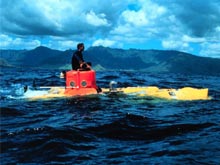Exploring the Northwestern Hawaiian Islands - Ho'ohuli
September 3 - November 5, 2003
![]() Video of a monk seal, swimming with deep-sea precious corals, showing no signs of stress at this depth. (mp4, 5.3 MB)
Video of a monk seal, swimming with deep-sea precious corals, showing no signs of stress at this depth. (mp4, 5.3 MB)
![]() Video of an unidentified squid from the submersible porthole. (mp4, 1.3 MB)
Video of an unidentified squid from the submersible porthole. (mp4, 1.3 MB)
![]() Video of a shark scavenging bait off Big Island, Hawaii, at 1,300 m. (mp4, 5.3 MB)
Video of a shark scavenging bait off Big Island, Hawaii, at 1,300 m. (mp4, 5.3 MB)
![]() Video of an amphipod trap in the pit crater of Loihi at 1,340 m. (mp4, 1.6 MB)
Video of an amphipod trap in the pit crater of Loihi at 1,340 m. (mp4, 1.6 MB)
About 70% of all U.S coral reefs are located in the Northwestern Hawaiian Islands (NWHI), a remote chain of small islands and atolls stretching 1,200 mi northwest of the main Hawaiian Islands.
During fall 2003, four scientific teams, comprised of scientists from the Hawaii Undersea Research Laboratory (HURL), the University of Hawaii at Manoa, Hawaii Pacific University, NOAA Fisheries, and Woods Hole Oceanographic Institution, explored targeted regions in the Northwestern Hawaiian Islands for 64 days aboard the University of Hawaii's Research Vessel Ka'imikai-o-Kanaloa. The HURL deep-sea manned submersibles, Pisces IV and Pisces V, and a remotely operated vehicle (ROV), were used to carry out the work.
Although most U.S. coral reefs are located in NWHI, the area's pristine deep-sea corals, submarine canyons, and seamounts are not well known. The major objectives of this expedition were to visit the region's virtually unexplored seamounts, believed to support unknown fish and invertebrate assemblages; to investigate the submarine habitat of the endangered Hawaiian monk seal with specific attention to its prey; to examine the reproductive biology and genetic composition of deep-sea corals; and to locate, map, and sample the beds of the species known as precious corals.
Accomplishments
Submarine Canyons and Seamounts
The scientists exploring submarine canyons and seamounts were thrilled by the abundance and diversity of life that they observed. Further analysis of the photographic evidence will take some time, as will the identification of the specimens collected. The results have great potential to include many interesting discoveries.
Monk Seal Habitat
During each of the submersible and ROV dives, detailed fish counts were conducted to document potential prey sources of monk seals and to better understand this very productive habitat. The first known association between deep-sea corals and monk seals was documented when a tagged monk seal peered into the porthole of the submersible at more than 500 m.
Deep-sea Coral Reproduction and Genetic Analysis
Numerous deep-sea coral species were collected and preserved for later studies of their reproductive biology. The population genetics of the collected coral species will also be studied. Some exciting preliminary discoveries included several new precious coral beds, 16 new coral species, a new genus of coral, and a new genus of crinoid (i.e., sea lily).
Education and Outreach
Outreach and education activities included lesson plans, a mission summary on the NOAA Ocean Explorer Web site (link: www.oceanexplorer.noaa.gov), a port event in Honolulu with media coverage, a regional stakeholders breakfast, ship tours for students and teachers, and a pierside ocean education fair. In addition, a field specialist and cameraman from the National Geographic Society's Remote Imaging Program covered the expedition as part of an ongoing project on monk seals for National Geographic's "Crittercam" series.
Participants
Hawaii Undersea Research Laboratory, University of Hawaii at Manoa, Hawaii Pacific University, NOAA's Pacific Island Fisheries Science Center, National Geographic Television and Film, Woods Hole Oceanographic Institution, University of Hawaii at Hilo, Smithsonian Institution, University of Alaska Fairbanks, University of Virginia, and the crews of the Research Vessel Ka'imikai-o-Kanaloa and the Pisces IV and Pisces V submersibles.
For more information on HURL, the technology used on the expedition, and the NWHI Coral Reef Ecosystem Reserve, click on the following links:
http://www.soest.hawaii.edu/hurl/ ![]()
http://www.hawaiireef.noaa.gov ![]()









